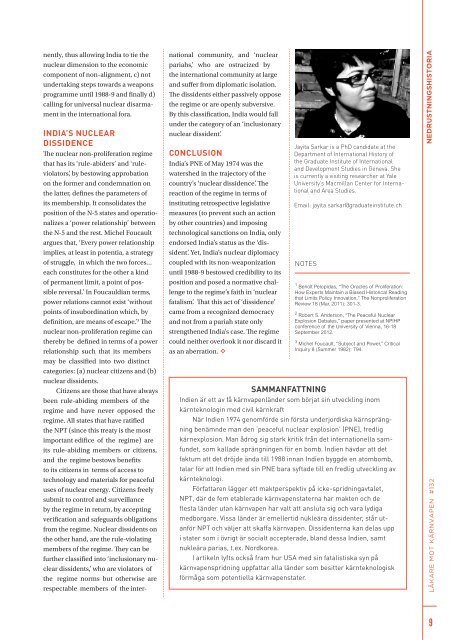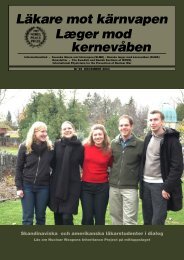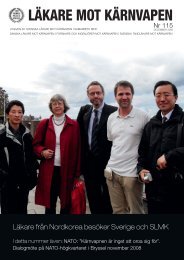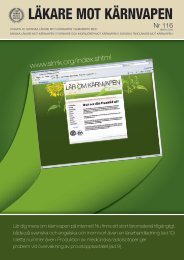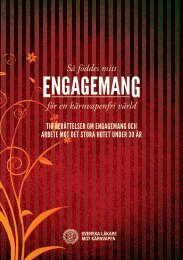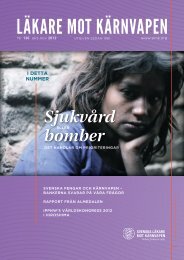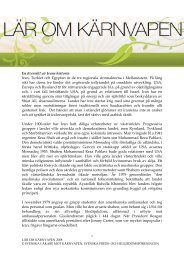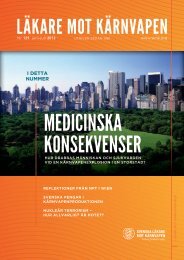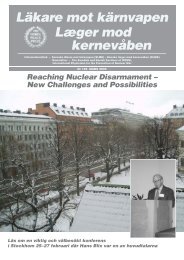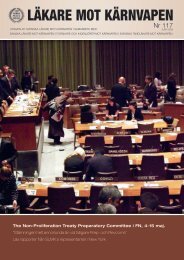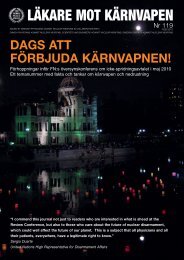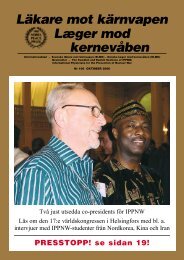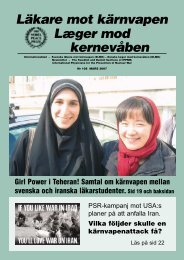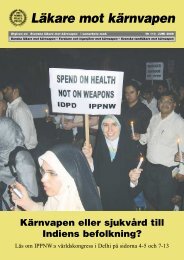i detta nummer - Svenska Läkare mot Kärnvapen
i detta nummer - Svenska Läkare mot Kärnvapen
i detta nummer - Svenska Läkare mot Kärnvapen
You also want an ePaper? Increase the reach of your titles
YUMPU automatically turns print PDFs into web optimized ePapers that Google loves.
nently, thus allowing India to tie the<br />
nuclear dimension to the economic<br />
component of non-alignment, c) not<br />
undertaking steps towards a weapons<br />
programme until 1988-9 and finally d)<br />
calling for universal nuclear disarmament<br />
in the international fora.<br />
INDIA’S NUCLEAR<br />
DISSIDENCE<br />
The nuclear non-proliferation regime<br />
that has its ‘rule-abiders’ and ‘ruleviolators’,<br />
by bestowing approbation<br />
on the former and condemnation on<br />
the latter, defines the parameters of<br />
its membership. It consolidates the<br />
position of the N-5 states and operationalizes<br />
a ‘power relationship’ between<br />
the N-5 and the rest. Michel Foucault<br />
argues that, ‘Every power relationship<br />
implies, at least in potentia, a strategy<br />
of struggle, in which the two forces…<br />
each constitutes for the other a kind<br />
of permanent limit, a point of possible<br />
reversal.’ In Foucauldian terms,<br />
power relations cannot exist ‘without<br />
points of insubordination which, by<br />
definition, are means of escape.’ 3 The<br />
nuclear non-proliferation regime can<br />
thereby be defined in terms of a power<br />
relationship such that its members<br />
may be classified into two distinct<br />
categories: (a) nuclear citizens and (b)<br />
nuclear dissidents.<br />
Citizens are those that have always<br />
been rule-abiding members of the<br />
regime and have never opposed the<br />
regime. All states that have ratified<br />
the NPT (since this treaty is the most<br />
important edifice of the regime) are<br />
its rule-abiding members or citizens,<br />
and the regime bestows benefits<br />
to its citizens in terms of access to<br />
technology and materials for peaceful<br />
uses of nuclear energy. Citizens freely<br />
submit to control and surveillance<br />
by the regime in return, by accepting<br />
verification and safeguards obligations<br />
from the regime. Nuclear dissidents on<br />
the other hand, are the rule-violating<br />
members of the regime. They can be<br />
further classified into ‘inclusionary nuclear<br />
dissidents,’ who are violators of<br />
the regime norms but otherwise are<br />
respectable members of the inter-<br />
national community, and ‘nuclear<br />
pariahs,’ who are ostracized by<br />
the international community at large<br />
and suffer from diplomatic isolation.<br />
The dissidents either passively oppose<br />
the regime or are openly subversive.<br />
By this classification, India would fall<br />
under the category of an ‘inclusionary<br />
nuclear dissident’.<br />
CONCLUSION<br />
India’s PNE of May 1974 was the<br />
watershed in the trajectory of the<br />
country’s ‘nuclear dissidence’. The<br />
reaction of the regime in terms of<br />
instituting retrospective legislative<br />
measures (to prevent such an action<br />
by other countries) and imposing<br />
technological sanctions on India, only<br />
endorsed India’s status as the ‘dissident’.<br />
Yet, India’s nuclear diplomacy<br />
coupled with its non-weaponization<br />
until 1988-9 bestowed credibility to its<br />
position and posed a normative challenge<br />
to the regime’s faith in ‘nuclear<br />
fatalism’. That this act of ‘dissidence’<br />
came from a recognized democracy<br />
and not from a pariah state only<br />
strengthened India’s case. The regime<br />
could neither overlook it nor discard it<br />
as an aberration. v<br />
Jayita Sarkar is a PhD candidate at the<br />
Department of International History of<br />
the Graduate Institute of International<br />
and Development Studies in Geneva. She<br />
is currently a visiting researcher at Yale<br />
University’s Macmillan Center for International<br />
and Area Studies.<br />
Email: jayita.sarkar@graduateinstitute.ch<br />
NOTES<br />
1 Benoît Pelopidas, “The Oracles of Proliferation:<br />
How Experts Maintain a Biased Historical Reading<br />
that Limits Policy Innovation,” The Nonproliferation<br />
Review 18 (Mar. 2011): 301-3.<br />
2 Robert S. Anderson, “The Peaceful Nuclear<br />
Explosion Debates,” paper presented at NPIHP<br />
conference of the University of Vienna, 16-18<br />
September 2012.<br />
3 Michel Foucault, “Subject and Power,” Critical<br />
Inquiry 8 (Summer 1982): 794.<br />
SAMMANFATTNING<br />
Indien är ett av få kärnvapenländer som börjat sin utveckling inom<br />
kärnteknologin med civil kärnkraft<br />
När Indien 1974 genomförde sin första underjordiska kärnsprängning<br />
benämnde man den ‘peaceful nuclear explosion’ (PNE), fredlig<br />
kärnexplosion. Man ådrog sig stark kritik från det internationella samfundet,<br />
som kallade sprängningen för en bomb. Indien hävdar att det<br />
faktum att det dröjde ända till 1988 innan Indien byggde en atombomb,<br />
talar för att Indien med sin PNE bara syftade till en fredlig utveckling av<br />
kärnteknologi.<br />
Författaren lägger ett maktperspektiv på icke-spridningavtalet,<br />
NPT, där de fem etablerade kärnvapenstaterna har makten och de<br />
flesta länder utan kärnvapen har valt att ansluta sig och vara lydiga<br />
medborgare. Vissa länder är emellertid nukleära dissidenter, står utanför<br />
NPT och väljer att skaffa kärnvapen. Dissidenterna kan delas upp<br />
i stater som i övrigt är socialt accepterade, bland dessa Indien, samt<br />
nukleära parias, t.ex. Nordkorea.<br />
I artikeln lyfts också fram hur USA med sin fatalistiska syn på<br />
kärnvapenspridning uppfattar alla länder som besitter kärnteknologisk<br />
förmåga som potentiella kärnvapenstater.<br />
NEDRUSTNINGSHISTORIA<br />
LÄKARE MOT KÄRNVAPEN #132<br />
9


